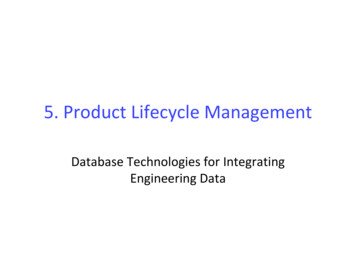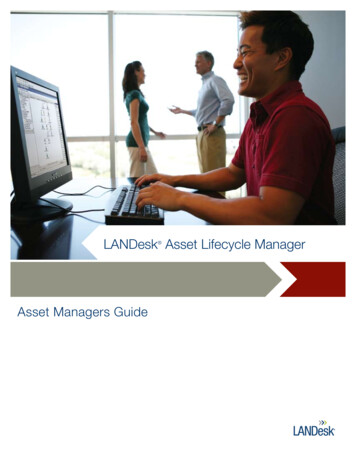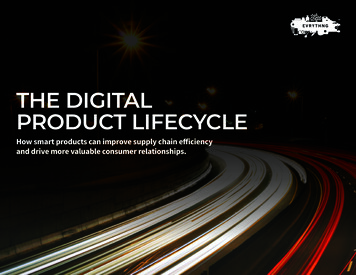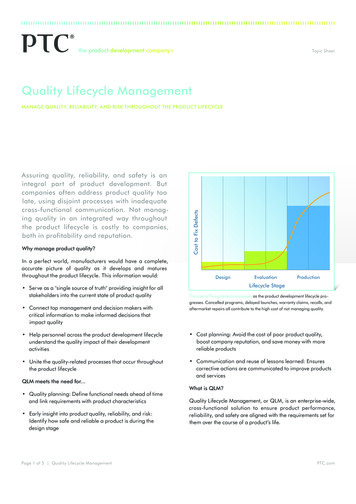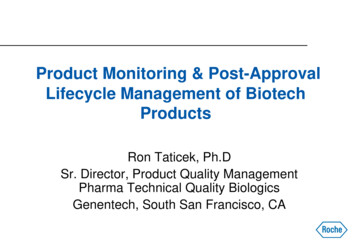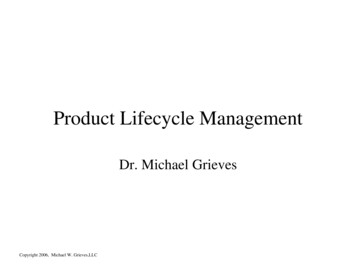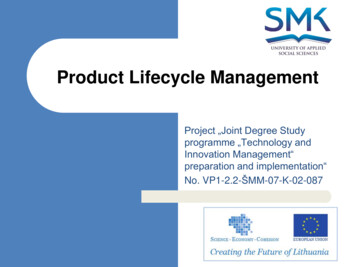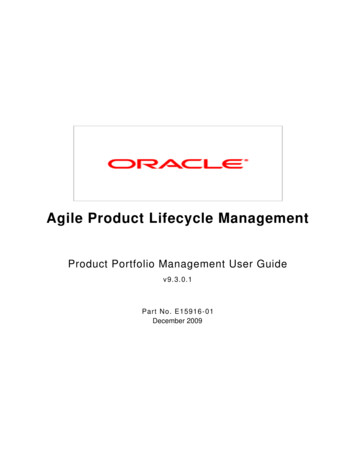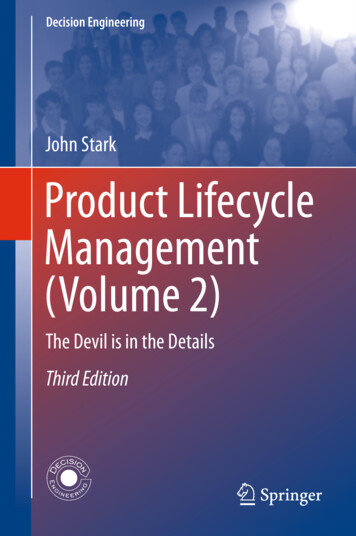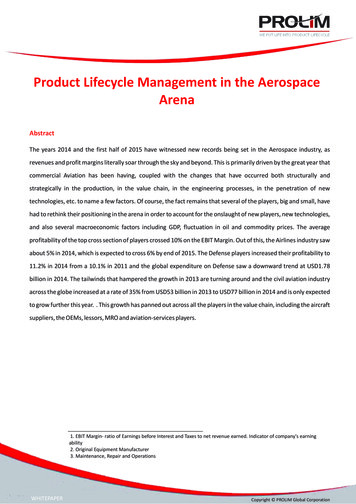
Transcription
Product Lifecycle Management in the AerospaceArenaAbstractThe years 2014 and the first half of 2015 have witnessed new records being set in the Aerospace industry, asrevenues and profit margins literally soar through the sky and beyond. This is primarily driven by the great year thatcommercial Aviation has been having, coupled with the changes that have occurred both structurally andstrategically in the production, in the value chain, in the engineering processes, in the penetration of newtechnologies, etc. to name a few factors. Of course, the fact remains that several of the players, big and small, havehad to rethink their positioning in the arena in order to account for the onslaught of new players, new technologies,and also several macroeconomic factors including GDP, fluctuation in oil and commodity prices. The averageprofitability of the top cross section of players crossed 10% on the EBIT Margin. Out of this, the Airlines industry sawabout 5% in 2014, which is expected to cross 6% by end of 2015. The Defense players increased their profitability to11.2% in 2014 from a 10.1% in 2011 and the global expenditure on Defense saw a downward trend at USD1.78billion in 2014. The tailwinds that hampered the growth in 2013 are turning around and the civil aviation industryacross the globe increased at a rate of 35% from USD53 billion in 2013 to USD77 billion in 2014 and is only expectedto grow further this year. . This growth has panned out across all the players in the value chain, including the aircraftsuppliers, the OEMs, lessors, MRO and aviation-services players.1. EBIT Margin- ratio of Earnings before Interest and Taxes to net revenue earned. Indicator of company's earningability2. Original Equipment Manufacturer3. Maintenance, Repair and OperationsWHITEPAPERCopyright PROLIM Global Corporation
ContentsAbstractIntroductionChallenges in the Aerospace Industry - Embracing PLMAdvantages of PLM in Aerospace ArenaConclusionReferencesAbout UsWHITEPAPER1334678Copyright PROLIM Global Corporation
IntroductionAerospace is a high technology industry that produces not only aircrafts and their engines, but also space vehicles,guided missiles, propulsion units, etc. The global Aerospace market primarily includes the following applicationsDefense, Commercial Aerospace, General Aviation, Helicopter, and Regional Jet. The major players in the UnitedStates are Department of Defense and NASA and in India the important names are HAL, ISRO and NAL (Aerospace).The primary regions that contribute significantly to these applications both in terms of the number of players in theindustry, the number of end users, OEMs, suppliers and other players along the value chain, as well as revenue areNorth America, Europe, APAC and ROW. It is estimated that the overall global Aerospace market will boom toUSD352.2 billion by the year 2033 and the main factors that will propel this growth world-wide would be the changein technologies, the high replacement rate, changes in the size of the aircraft and the increase in high net-worthpopulation (Global Aerospace Market Trends and Forecasts: 2014-2033, 2015) . Given this ever changing scenarioas well as the evolving dynamics of a fast growing industry, all the players along the Aerospace value chain are havingto restructure, rethink, redesign, and strategize their position in the market to stay ahead of the competition. Withconstant innovation being the name of the game, digitization not only of their technologies but of the entire productlifecycle becomes an urgent ask.Challenges in the Aerospace Industry - Embracing PLMThe Aerospace industry has always been way ahead of the other industries in terms of adoption of the latesttechnologies. They were the first adopters of the CAD when it came into being in the 1960s. It has become critical forthem to adopt the latest technologies in order to avoid getting into complexities of the aircrafts, variousgovernmental and spatial regulatory requirements, long service life, exacting operational demands and of coursethe safety regulations and demands. The use of advanced technologies for design, engineering, production,planning, simulation and all the other aspects of the supply chain, including all the players involved becomes aquestion of survival for the Aerospace industry players. With so many players permeating the air space, it also is aquestion of the survival of the fittest.4. National Aeronautics and Space Administration5. Hindustan Aeronautics Limited6. Indian Space Research Organization7. National Aerospace Laboratories8. Asia Pacific9. Rest Of the World10. Computer Aided DesignWHITEPAPERCopyright PROLIM Global Corporation
However, despite the advanced technologies being used, the amount of data and information that is required forevery single aspect of the huge network that goes into creating an Aerospace supply chain, is limitless. This meansthat working with them in individual silos is an impossibility and given the fact that it takes a minimum of ten years todevelop and three decades for product service, maintaining the integrity of the data also comes underscrutiny (Grasson, 2012). Also, given the fact that there are several OEMs and external networks that need to bemanaged and legacy applications to be optimised, the Aerospace market is not only huge, it is also extremelycomplex to say the least and these in turn have led to the adoption of PLM solutions. This helps them in better timeto market, lower costs and increased revenues.Advantages of PLM in Aerospace ArenaThose Aerospace players who have already adopted several digital trends like Big Data, Analytics, Social, Media, andCloud are already seeing the ROI. Those who have embraced PLM as a part of their development processes havealready seen an acceleration of 20% to 50% in the development time, along with the associated cost savings. Manycompanies have already made the move to other technologies like Additive manufacturing, Lightweighting,Modular Information systems, Cloud solutions, etc. The main advantages and industry-wide implications though are(Aerospace):lllImproved quality of supplyReduced design to manufacture timeImproved responsiveness to service and maintenanceOn a broader scale though, the repercussions that PLM can have on the Aerospace arena are tremendous:1. One unified system – The lack of a PLM system will indicate information on ERPs, CRMs, Excel, databases,disparate file servers, emails, etc. PLM acts in unifying all requisite data on one single source that can be accessedthrough one single application2. Security and Compliance – Aerospace industry has a long development cycle and an even longer product life,which means that the adherence to stringent regulations depends on how secure and reliable the stored data is andhow easily it can be accessed and retrieved. These companies have the added burden of addressing export controlregulations on data, multi-nationality and air space regulations, etc., which can be addressed from one single pointnow3. Networking – The OEMs and the other teams are mostly third party vendors. Having a need for huge amounts ofsimulation data, tools, infrastructure, and software to be shared with multiple teams, internal and external, acrosscontinents sometimes can be almost impossible without PLM11. Product Lifecycle ManagementWHITEPAPERCopyright PROLIM Global Corporation
4. Define business processes – Bill of Materials(BOMs), changes, workflows, parts, phase-gate, etc. can easily bestored with the right accessibility permissions as well as with in-built reports access when required5. Robust documentation management – With so much of documentation to manage, PLM gives the industry arobust solution that ties both the engineering data as well as all the documentation together6. Comprehensive solution – PLM enables digital simulation and mock-up, process and data management,configuration management, better quality control that extends even to suppliers base, change management, fieldtesting solutions, and much more on an open, modular and easily scalable platform7. MRO solutions – PLM maintains the required data to address maintenance, repair and operational roadblocks8. RFLP – PLM solutions, when integrated early on, can help from Requirements to Features to Logical to Physicalstages of the product lifecycle. This means that Aerospace companies can work from start to finish using onecomprehensive platform that allows a multi-directional flow of information with minimum manual intervention andlow room for errors. This also negates the need for mid-stream reconfiguration and shows the path to realization ofthe benefitsPLM solutions provided by solutions providers typically include, but are not limited to:Application development, PLM Scan and 4D Process Consulting, Data Migration services, Implementation services,Data Validation services, Product Data Management etc.WHITEPAPERCopyright PROLIM Global Corporation
ConclusionAerospace companies have the constant need to provide faster-better-cheaper and more innovative solutions thatcome under all the security and compliance regulatory umbrellas. They need to continuously innovate the way theydesign, create, and produce their products and PLM gives them the support of one comprehensive platform thatallows them to do so. They are beginning to use new initiatives to transition their design technologies and existingsystems into a comprehensive PLM solution and most are aiming to embrace the 3D PLM environment where all theplayers in the supply chain can virtually interact with the product as if it is a physical object. The latest component inthe PLM space, Digital manufacturing, lets them do just that. It is well known fact that the Boeing-787 was designedin a 3D PLM environment from start to finish.WHITEPAPERCopyright PROLIM Global Corporation
ReferencesAerospace. (n.d.). Retrieved from Wikipedia: https://en.wikipedia.org/wiki/AerospaceGlobal Aerospace Market Trends and Forecasts: 2014-2033. (2015, February 02). Retrieved from PRNewswire.com: 87.htmlGrasson, M. (2012, May 11). The Benefits of OLM. Retrieved from Aerospace Manufacturing and Design -lifecycle-management-softwareRecord year for Aerospace and Defense industry driven by continued boom in commercial aviation. (2015, June11). Retrieved from pyright PROLIM Global Corporation
About PROLIM: PROLIM is a leading provider PLM Software Services to industries like Automotive, Aerospace, ManufacturingSupplier and Life Sciences. Providing these services has helped the clients to enhance efficiency and top-line growthAs one of the fastest growing private Companies in America recognized by Inc 500, PROLIM being customer focusedrather than product focused, the company envisions harnessing customer requisites by adding more satellite officesover the next few years in major metropolitan centers PROLIM envisages reaching customers beyond borders todeliver effective services in the west and east coasts of the US Canada and Europe and Asia.US OFFICE – DALLASPROLIM Global Corporation2805 N. Dallas Parkway, Suite 610Plano, TX 75093Phone: 214-945-2667US OFFICE – DETROITPROLIM Global Corporation30445 Northwestern Hwy, Suite 380Farmington Hills, MI 48334Phone: 248-522-2575CANADA OFFICEPROLIM Canada Inc4611 Rosebush Road,Mississauga L5M 5H2,CanadaPhone: 416-220-2892INDIA OFFICEPROLIM Solutions Pvt. Ltd.World Trade Center20th Floor, Malleswaram,Bangalore 560055Phone: 91 80-41637666WHITEPAPERCopyright PROLIM Global Corporation
Product Lifecycle Management in the Aerospace Arena Abstract The years 2014 and the first half of 2015 have witnessed new records being set in the Aerospace industry, as revenues and profit mar

